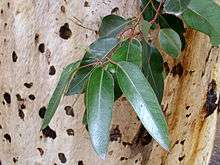Eucalyptus cladocalyx
| Sugar gum | |
|---|---|
 | |
| Scientific classification | |
| Kingdom: | Plantae |
| Clade: | Angiosperms |
| Clade: | Eudicots |
| Clade: | Rosids |
| Order: | Myrtales |
| Family: | Myrtaceae |
| Genus: | Eucalyptus |
| Species: | E. cladocalyx |
| Binomial name | |
| Eucalyptus cladocalyx | |
| E. cladocalyx, field distribution | |
| Synonyms | |
|
Eucalyptus corynocalyx F. Muell. Eucalyptus langii Maiden & Blakely | |
.jpg)
Eucalyptus cladocalyx, commonly known as sugar gum, is a species of eucalypt tree found in the Australian state of South Australia. It is found naturally in three distinct populations - in the Flinders Ranges, Eyre Peninsula and on Kangaroo Island. It has no known close relatives.[1]
Description
The tree notable for its mottled colourful yellow to orange bark, strongly discolourous leaves and inflorescences grouped on leafless branchlets inside the tree crown. The old bark is smooth and grey, shedding in irregular patches to expose the fresh yellowy-brown bark. Flowers are creamy-white in summer. The capsules are barrel to urn shaped.
Sugar Gums from the Flinders Ranges reach up to 35 metres (115 ft) in height[1] and have the classic "gum" habit - with a straight trunk and steep branches occurring about halfway up. Each main branch ends with its own little canopy. These are commonly cultivated as farm windbreaks and for timber. However, Eyre Peninsula and Kangaroo Island trees are much shorter and often have crooked trunks.
Classification
The species was first formally described by the botanist Ferdinand von Mueller in 1853 as part of the work Diagnoses et descriptiones plantarum novarum, quas in Nova Hollandia. as published in the journal Linnaea: ein Journal für die Botanik in ihrem ganzen Umfange, oder Beiträge zur Pflanzenkunde.[2] There are two known synonyms for the species; Eucalyptus corynocalyx as described by Ferdinand von Mueller and Eucalyptus langii as described by Joseph Maiden & William Blakely.[3]
Uses
The tree is commonly planted across southern Australia for use as a windbreak or shelterbelt, or for timber and firewood production. The wood is termite resistant, with moderate strength and durability and can be used for furniture, flooring, posts, construction timber and for railway sleepers.[1]
It has now become naturalised in the South West region of Western Australia, in southern Victoria, and beyond its native range in some parts of south-eastern South Australia. Also naturalised overseas in southern Africa, in California and Hawaii.[3]
References
- 1 2 3 "Eucalyptus cladocalyx". Florabank. Retrieved 30 July 2017.
- ↑ "Eucalyptus cladocalyx F.Muell". Atlas of Living Australia. Global Biodiversity Information Facility. Retrieved 30 July 2017.
- 1 2 "Eucalyptus cladocalyx F. Muell". Weeds of Australia. Queensland Government. Retrieved 30 July 2017.
- Holliday, I. A field guide to Australian trees (3rd edition), Reed New Holland, 2002
- Cronin, L. Key Guide to Australian Trees, Envirobook, 2000
- Rawlings, M. Regional allozyme divergence in Sugar Gum, Eucalyptus cladocalyx, 2005, Centre for Plant Biodiversity Research